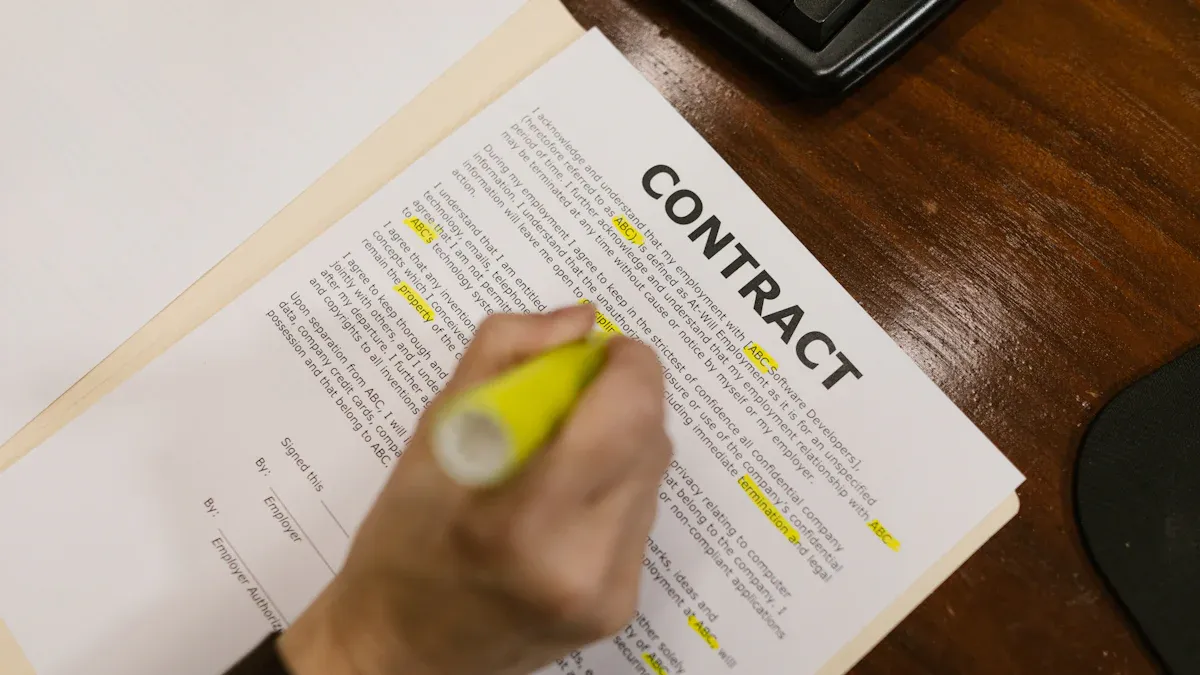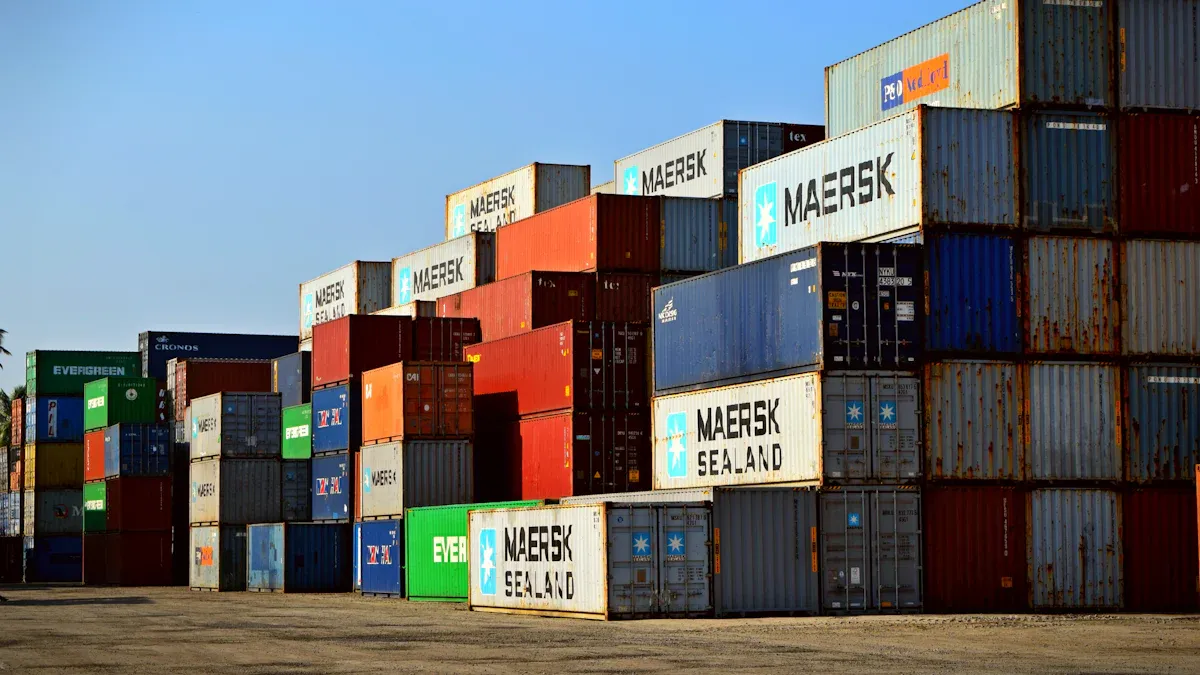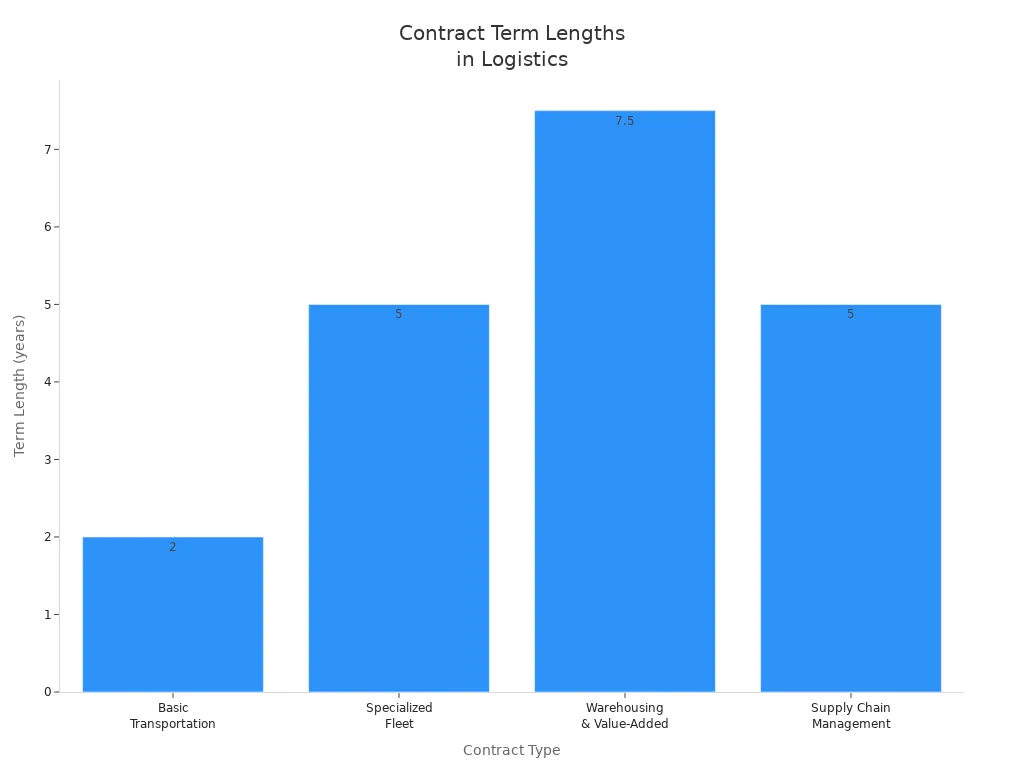How to understand logistics service contract terms and conditions

You want to understand logistics service contract terms and conditions, so start by looking for the parts that spell out your rights, duties, and risks. When you know what each clause means, you protect your business and avoid expensive mistakes. Take a look at this table to see how clear contract terms help your business:
Component | Impact on Business Outcomes |
|---|---|
Clear expectations | Reduces misunderstandings and aligns goals between parties. |
Defined responsibilities | Ensures accountability and performance tracking. |
Performance metrics | Facilitates assessment of service quality and efficiency. |
Governance model | Helps manage relationships and resolve disputes. |
Service credits/bonuses | Incentivizes high performance and service quality. |
If you review contracts step by step, you can spot cost-saving opportunities, better delivery times, and access to new technology. You don’t need to be an expert—just take your time and ask questions when something isn’t clear.
Key Takeaways
Understand your rights and responsibilities in logistics contracts to avoid costly mistakes.
Use clear language in contracts to set expectations and reduce misunderstandings.
Regularly review contracts to stay updated on terms and ensure compliance.
Incorporate performance metrics to track service quality and hold providers accountable.
Ask questions and seek clarification on unclear clauses to protect your business interests.
Logistics service contract terms and conditions

When you look at logistics service contract terms and conditions, you see how every detail shapes your business relationship. These contracts set the rules for how you work with your logistics provider. If you want to avoid confusion and costly mistakes, you need clear, simple language. Both sides benefit when everyone knows what to expect and what they must deliver.
Tip: Always read each clause carefully. If you spot unclear language, ask for clarification before you sign.
A well-written contract helps you manage risks, track performance, and resolve disputes quickly. You get a roadmap for your partnership, and you know who is responsible if something goes wrong. Whether your agreement is domestic or international, the terms and conditions guide how you handle legal issues, liability, and compliance.
Scope and Exclusivity
Scope defines what services your logistics provider will deliver. You want this section to be specific. It should list duties, responsibilities, and deliverables. If you skip details, you might face disputes later. A solid contract sets clear expectations and makes sure you get the services you need, when you need them.
You protect your interests by spelling out every service.
You avoid misunderstandings by listing what’s included and what’s not.
You keep operations smooth and reduce the chance of arguments.
Exclusivity clauses decide if you work only with one provider or if you can use others. These rules can help you get better prices or special treatment, but they also come with risks. If you rely on one company, you might lose flexibility or miss out on new opportunities.
Advantage/Disadvantage | Description |
|---|---|
Competitive Advantage | You get a unique selling point and may win more customers. |
Cost Savings | Exclusive deals can bring bulk discounts and lower costs. |
Risk of Dependence | Relying on one provider can be risky if they have problems. |
Reduced Flexibility | You may lose the ability to negotiate or switch providers easily. |
If you want to protect your business, weigh the pros and cons before agreeing to exclusivity.
Service Levels (SLAs) and KPIs
Service Level Agreements (SLAs) and Key Performance Indicators (KPIs) show how your provider measures up. These parts of logistics service contract terms and conditions help you track quality, speed, and accuracy. You can see if your provider meets your standards or if you need to make changes.
KPI/Metric | Description |
|---|---|
On-time Performance | Measures how often deliveries arrive as promised. |
Inventory Records Accuracy | Tracks how well inventory matches records. |
Quality Assurance | Checks the quality of goods upon delivery. |
Cost Per Order (CPO) | Shows the cost for each processed order. |
Return Processing Time | Measures how fast returns are handled. |
Voice of the Customer (VOC) feedback | Collects customer opinions for improvement. |
You can use these metrics to reward good performance or fix problems. If you set clear SLAs and KPIs, you make sure your provider knows what matters most to you.
Note: Always include bonus or penalty clauses tied to KPIs. This motivates your provider to deliver top results.
Pricing and Indexation
Pricing is a big part of logistics service contract terms and conditions. You want to know how much you pay and how prices can change. Many contracts use index-based pricing, which means your rates adjust based on market trends. This keeps costs fair for both sides.
You might see contracts with annual, quarterly, or spot market pricing. Indexation links your rates to a third-party index, so you don’t get stuck with outdated prices. This method helps you plan your budget and avoid surprises.
You get transparency in how prices are set.
You can adjust costs if the market shifts.
You avoid disputes over unexpected charges.
If you want to keep your logistics costs under control, make sure your contract explains how pricing and indexation work.
Tip: Ask for a clear explanation of how price changes happen. This helps you avoid confusion and plan ahead.
Risk and Responsibility

When you look at logistics service contract terms and conditions, you see how risk and responsibility shape your business partnership. You want to know who pays if something goes wrong, who carries the risk, and how you can protect yourself. Let’s break down the main parts that help you manage risk.
Liability Clauses
Liability clauses tell you what each party is responsible for if things go wrong. These rules decide who pays for mistakes, delays, or lost goods. You want to read these clauses closely because they can save you from big losses.
A logistics company, QuickLogistics, signs a contract with a client for the transportation of goods. The contract includes a liability clause stating QuickLogistics will not be liable for consequential or indirect losses, loss of profits or business opportunities, resulting from breaches of contract, such as delays in deliveries. If a delivery is delayed and the client loses £50,000 in potential sales due to stock shortages, QuickLogistics cannot be held accountable for those lost profits.
Most liability clauses focus on two things: what you can be sued for and how much you can be sued for. If you set clear limits, you protect your business from huge claims. You also know exactly what you’re responsible for.
Limiting liability for indirect or consequential losses helps protect against unpredictable financial risks.
Setting caps on financial liability ensures that compensation remains manageable.
Clarity in the scope of services and responsibilities prevents misunderstandings and potential disputes.
Liability limits change depending on where you do business. In Europe, the CMR Convention sets a limit for road transport. In the U.S., the Carmack Amendment lets you negotiate limits. Some contracts have strict rules, while others let you work out the details.
CMR Convention: Limits liability to 8.33 SDR per kilogram for road transport in Europe.
COTIF Convention: Governs rail transport liability with specific limits based on goods and circumstances.
Carmack Amendment: No cap on liability for motor carriers in the U.S., but parties often negotiate limits.
If you want to avoid surprises, always check how liability works in your region.
Insurance
Insurance is your safety net. It helps you recover losses if something bad happens. You want to make sure your logistics service contract terms and conditions list the right types of insurance.
Cargo Insurance: Protects against lost or damaged cargo, covering various types of goods.
Commercial Vehicle Insurance: Mandatory for business vehicles, covering liability from accidents.
Commercial General Liability Insurance: Covers legal liabilities related to personal injury and property damage.
Freight Forwarder Insurance: Covers cargo loss, errors in documentation, and regulatory compliance.
Freight Broker Insurance: Protects against contract disputes and cargo claims.
Last Mile Delivery Insurance: Addresses liability and cargo loss during final transit.
Insurance requirements help both sides feel safe. If you have the right coverage, you don’t have to worry about paying for every mistake or accident. Insurance also builds trust between you and your provider.
Insurance requirements in contracts are crucial as they not only safeguard parties from damages but also serve to reduce the risk of exposure. This is vital for ensuring that neither party suffers losses due to incidents that occur during the execution of the contract.
Insurance requirements in logistics contracts help safeguard both parties from damages.
They reduce risk exposure and establish trustworthiness, which is essential for a healthy professional partnership.
The specific lines of insurance required and the financial stability of insurers influence how risk is shared and managed.
Institutions may transfer as much risk as possible to the other party.
The approach to risk allocation may vary based on the subject matter or the nature of activities performed under the agreement.
If you want to protect your business, always check the insurance section and ask questions if you don’t understand what’s covered.
Lien and Retention Rights
Lien and retention rights give you legal tools to protect your money. If someone owes you payment, you can hold onto their goods until they pay. This helps you avoid losses and encourages people to pay on time.
Lien and retention rights are crucial legal tools in logistics contracts that protect creditors' interests. The right of lien allows creditors to claim certain goods if the debtor becomes insolvent, while retention enables creditors to withhold goods until payments are made. These mechanisms encourage timely payments and safeguard creditors from losses.
If you’re a logistics provider, these rights help you get paid. If you’re a client, you need to know when your goods might be held. Always check this part of your contract so you know what to expect.
How Contracts Shift Risk
Some contracts move risk from one party to another. Shipper-driven contracts often shift risk to the carrier or buyer. Here’s a quick look at how risk moves in different contract types:
Contract Type | |
|---|---|
Free Carrier (FCA) | Risk passes from the shipper to the carrier upon delivery of the goods to the carrier, protecting shippers from liability during transit. |
Shipment Contract | Risk of loss shifts from the seller to the buyer when goods are delivered to the carrier, with the buyer assuming risk regardless of subsequent loss or damage. |
Destination Contract | Seller retains risk of loss until goods reach the buyer’s specified destination, safeguarding the buyer’s interests until delivery is complete. |
If you want to manage risk, always check who carries it at each stage.
Smart Risk Management Strategies
You can use smart strategies to keep your business safe. Here are some ideas:
Scenario planning: Prepare for disruptions by thinking through “what if” situations.
Supplier diversification: Work with more than one supplier to avoid problems if one fails.
Contingency planning: Make action plans for emergencies.
Flexible shipping options: Use different transport methods to keep goods moving.
Using data and analytics: Study past problems to avoid future ones.
Diversifying suppliers and routes: Plan alternate routes and suppliers to avoid shutdowns.
Improving visibility and monitoring: Use tracking systems to see where your shipments are.
Keeping buffer stock: Store extra inventory to avoid delays.
Strong contracts and insurance: Write clear agreements and get insurance to protect against loss.
If you use these strategies, you can handle risks and keep your business running smoothly.
Contract Management and Termination
Term and Termination
When you sign a logistics service contract, you need to know how long it lasts and how you can end it. The contract term sets the time you and your provider work together. Some contracts last only two years, while others can go up to ten years. Longer contracts help you plan better and give your provider time to invest in new trucks or warehouses.
Contract Type | Standard Term Length | Implications for Business Continuity |
|---|---|---|
Basic Transportation & Freight | Short terms may lead to instability in logistics operations and hinder long-term investments by LSPs. | |
Specialized Fleet (e.g., refrigerated trucks) | 5 years | Longer terms allow LSPs to recover investments and ensure continuity in service delivery. |
Warehousing & Value-Added Logistics | 5 to 10 years | Extended terms are necessary for significant investments in infrastructure and compliance with regulations. |
Supply Chain Management | 5 years | Longer contracts enable advanced collaborations, maximizing cost reductions and operational efficiencies. |

You also need to know how to end the contract if things go wrong. Most logistics service contract terms and conditions include these ways to end a deal:
Description | |
|---|---|
Immediate Termination | You can end the contract right away if there is a serious problem, but the other side should get a chance to fix it. |
Termination for Cause | You can end the contract if the other side breaks the rules or does not do their job. |
Termination for Convenience | You can end the contract for any reason if it no longer works for you. |
Tip: Always track contract deadlines and set reminders for renewals or reviews. This helps you avoid surprises and keeps your business running smoothly.
Compliance and Dispute Resolution
You need to follow the rules in your contract. Good compliance keeps your business safe and helps you avoid legal trouble. Here are some things you should look for:
Contract Element | Description |
|---|---|
Payment Terms | The contract should say when you pay and how you pay. |
Penalties for Late Payments | If you pay late, you might have to pay extra fees. |
Extra Charges | The contract should explain how extra costs, like waiting fees, are calculated. |
The contract should tell you how to solve problems, like using mediation before going to court. |
Creating clear and detailed contracts that outline responsibilities, timelines, liabilities, protocols for unforeseen circumstances, and dispute resolution procedures can help prevent disputes from arising in the first place.
If you want to avoid problems, use these best practices:
Keep all your contracts and documents in one place.
Use reminders to track important dates.
Review your contracts often to make sure you follow the rules.
Use electronic signatures to make things faster.
Involve the right people when you make or change a contract.
When a dispute happens, you can solve it in many ways:
Talk to your provider and try to fix the problem early.
Use mediation or other quick solutions before going to court.
Check your contract for clear steps to handle disagreements.
If you manage your contracts well, you build trust and keep your business strong. Good contract management helps you avoid fines, legal trouble, and lost business.
You can avoid costly mistakes by reading every clause, asking questions, and getting expert advice. A checklist helps you cover all the important parts, like payment terms, contract length, and scope of services. Here’s what you should always check:
Parties and contact details |
Contract duration |
Scope of services |
Payment terms |
Performance metrics |
Confidentiality and IP clauses |
Termination and renewal terms |
Review contracts each year to keep up with changes.
Use clear language and set reminders for deadlines.
Talk with your provider to solve problems early.
Proactive contract management builds trust and keeps your business running smoothly.
FAQ
What should you do if you don’t understand a contract clause?
Always ask your provider for a clear explanation. If you still feel unsure, talk to a legal expert. Never sign a contract if you don’t understand every part.
Can you change contract terms after signing?
You can change terms, but both sides must agree. Write down any changes and have everyone sign. Keep a copy of the updated contract for your records.
Why are SLAs and KPIs important in logistics contracts?
SLAs and KPIs help you track if your provider meets your needs. They set clear goals for delivery times, quality, and service. This keeps everyone accountable.
What happens if your provider breaks the contract?
You can end the contract for cause.
You may get compensation for losses.
Always check your contract for the right steps to follow.
Tip: Act quickly if you notice a problem. This helps protect your business.
See Also
Key Strategies for Effective Global Logistics Operations
Understanding Fundamental Elements of Global Logistics Best Practices
Critical LCL Shipping Steps for Exporting from Panama
PGL's Knowledge in Global Logistics and Supply Chain Solutions
Comprehensive Ocean Export Services for FCL and LCL from U.S. Ports
